Secure your Angular Applications


Gleb Bahmutov
aka "Dr Gleb"
Day 1
Track 2
11:00
Gleb Bahmutov
Conferences: ng-conf, AngularConnect 2016, etc.
I write things down
58 blog posts tagged "angularjs"
@bahmutov
- "Unit testing AngularJS code in record time"
- "Stop (silent) Angular (name) overrides"
- "Improving Angular web app performance"
Practical Angular advice for my team
@bahmutov
Work at Kensho
A DATA ANALYTICS AND MACHINE INTELLIGENCE COMPANY


Boston / NYC
Work at Kensho
A DATA ANALYTICS AND MACHINE INTELLIGENCE COMPANY
What happens to the value of X when Y happens?
@bahmutov
The Keynote was like

@bahmutov
This presentation is like

Source: Uruk (modern Iraq)
time
today
2013
future
Presentation timeline
Angular 1.0
Angular 1.x
Vue.js
Aurelia
Angular 2
OWASP top 10
Server-side
rendering
No more security?
1985

The Theme
Security is compromised when there is mismatch of expectations between two parts of the system
@bahmutov
Example
Database code assumes user email has been validated and sanitized
sqlCommand('SELECT * FROM USERS WHERE email=' + email)@bahmutov
Example
Website code assumes database code checks the email in secure fashion
sqlCommand('SELECT * FROM USERS WHERE email=' + email)https://mysite.com/user?email=joe@mysite.com or 1=1https://mysite.com/user?email=joe@mysite.comInjection attack
Example
Mismatch of expectations between the website and database systems
// the input data has been sanitized and can be trusted// I expect SQL library to guard against invalid inputsInjection attack
2013 uTest (now Applause)
Mobile test + crash + App Store data = profit
@bahmutov
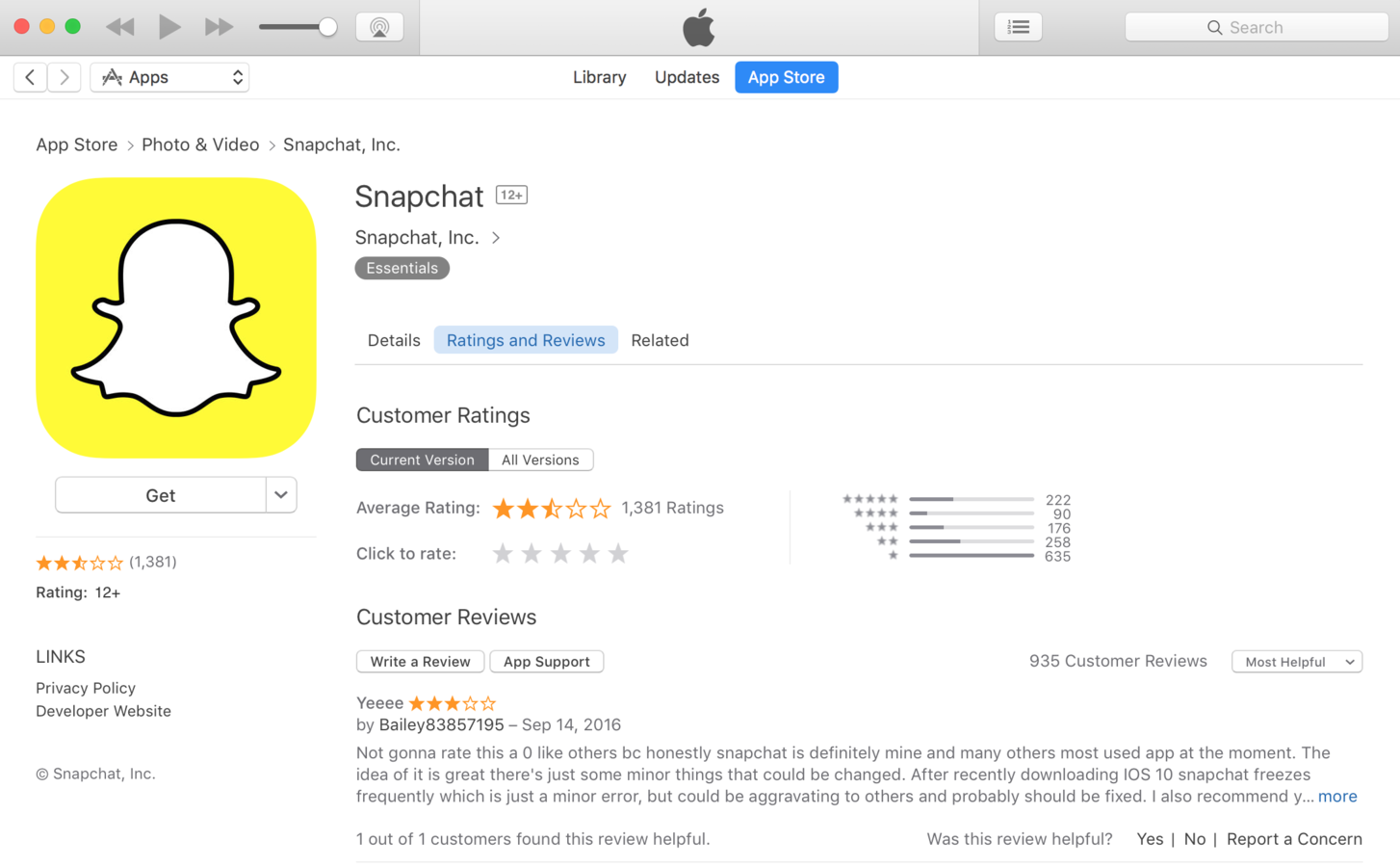
performance, crashes
performance - 2 stars
reliability - 1 star
ui features - 0.5 stars
....
@bahmutov
Current rating: 2.5
+ performance improvements
= 4.5
@bahmutov
Let us build a dashboard!
-
Angular 1
-
Node
-
various data sources
-
multiple audiences
@bahmutov
Designer
Me
mockups
website


Mockups
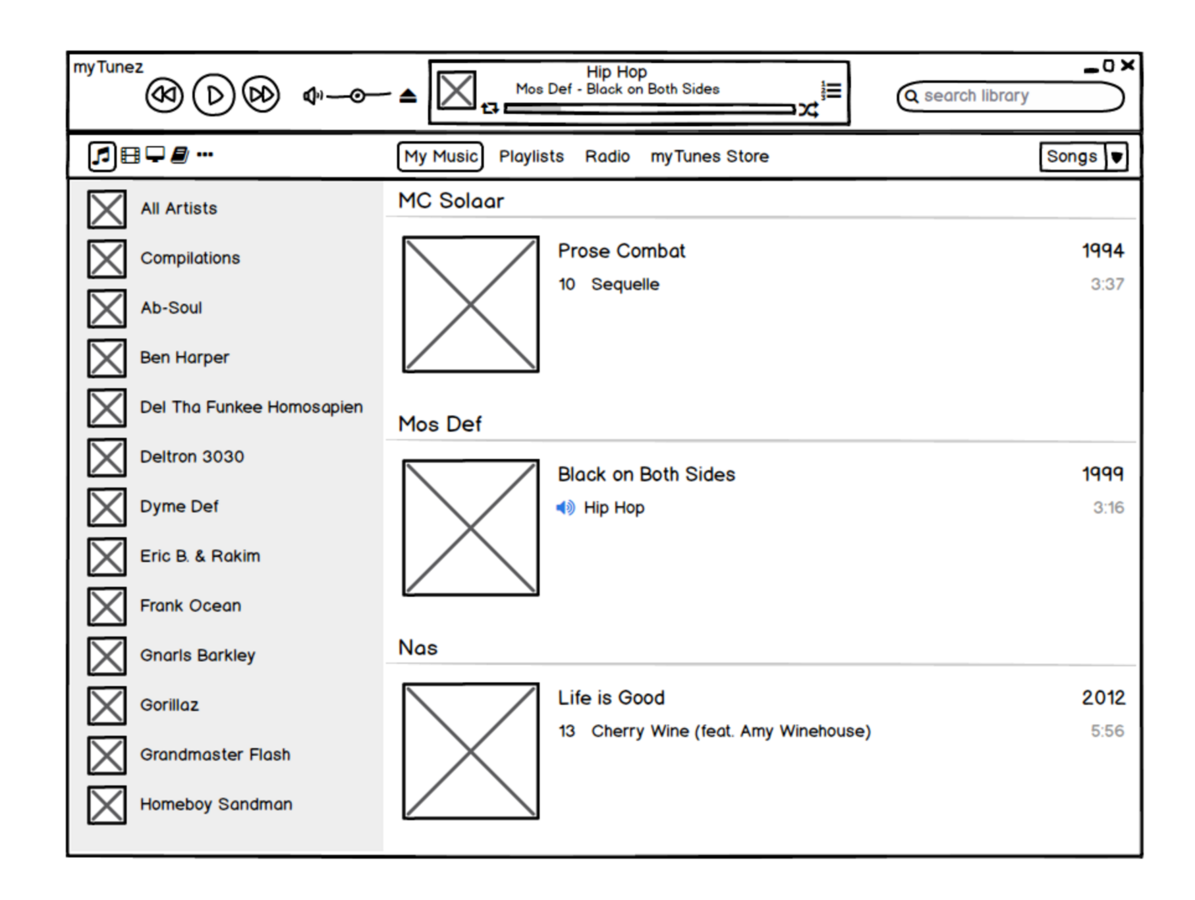
Balsamiq mockup https://balsamiq.com/products/mockups/
Business idea: export mockups as web components

Balsamiq mockup https://balsamiq.com/products/mockups/
Complex state and REST are saving our jobs, people!

Balsamiq mockup https://balsamiq.com/products/mockups/
Pixel pushing
Lorem ipsum dolor sit amet, esse deseruisse dissentias et duo, in tantas putant urbanitas nam. Per dicant copiosae ea, duo ex omnesque copiosae. In rebum zril integre mea, an zril ornatus disputando pri. Mei at laudem ceteros, vidisse electram intellegam mel an, amet consul qui eu. Vix id melius consetetur, nam ea congue legimus oportere. Vim ne fastidii volutpat salutatus, nulla ludus at duo.
@bahmutov
@bahmutov
Hue / Saturation / Value
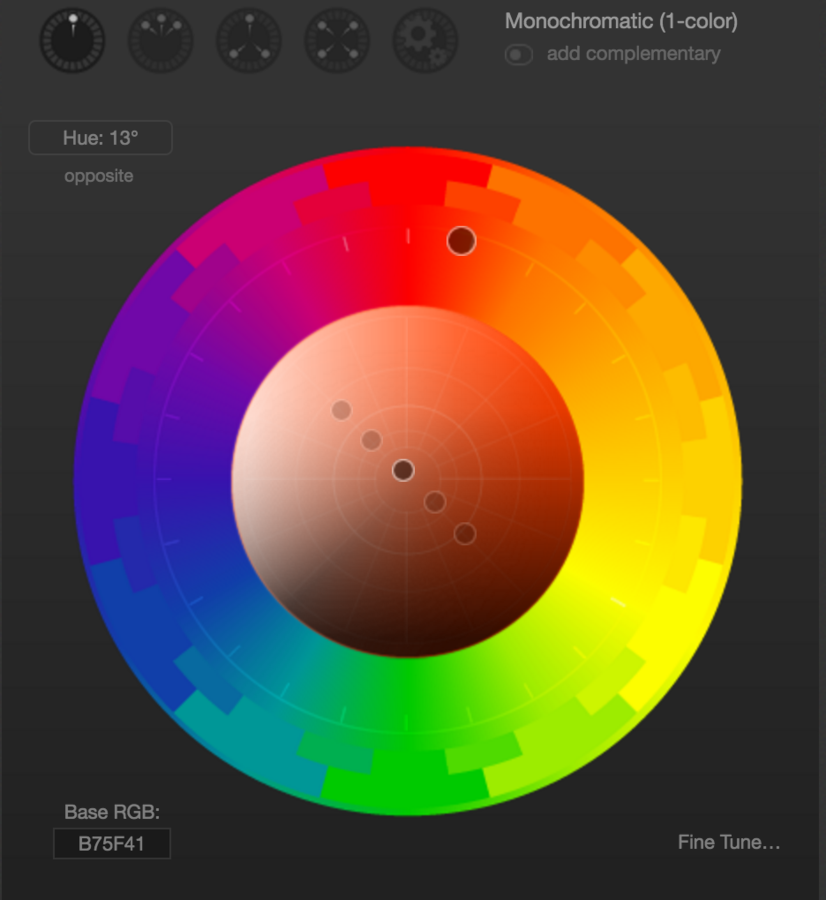
saturation
grey
red
@bahmutov
Hue / Saturation / Value

value
dark
light
@bahmutov
Designer: red!
bold! white space!
Me: so like #ff000 and padding 3em?
@bahmutov
Color pushing
Lorem ipsum dolor sit amet, esse deseruisse dissentias et duo, in tantas putant urbanitas nam. Per dicant copiosae ea, duo ex omnesque copiosae. In rebum zril integre mea, an zril ornatus disputando pri. Mei at laudem ceteros, vidisse electram intellegam mel an, amet consul qui eu. Vix id melius consetetur, nam ea congue legimus oportere. Vim ne fastidii volutpat salutatus, nulla ludus at duo.
This background?
@bahmutov
Color pushing
Lorem ipsum dolor sit amet, esse deseruisse dissentias et duo, in tantas putant urbanitas nam. Per dicant copiosae ea, duo ex omnesque copiosae. In rebum zril integre mea, an zril ornatus disputando pri. Mei at laudem ceteros, vidisse electram intellegam mel an, amet consul qui eu. Vix id melius consetetur, nam ea congue legimus oportere. Vim ne fastidii volutpat salutatus, nulla ludus at duo.
Or this background?
@bahmutov
Color pushing
Lorem ipsum dolor sit amet, esse deseruisse dissentias et duo, in tantas putant urbanitas nam. Per dicant copiosae ea, duo ex omnesque copiosae. In rebum zril integre mea, an zril ornatus disputando pri. Mei at laudem ceteros, vidisse electram intellegam mel an, amet consul qui eu. Vix id melius consetetur, nam ea congue legimus oportere. Vim ne fastidii volutpat salutatus, nulla ludus at duo.
#1e1e1e
#222222
@bahmutov
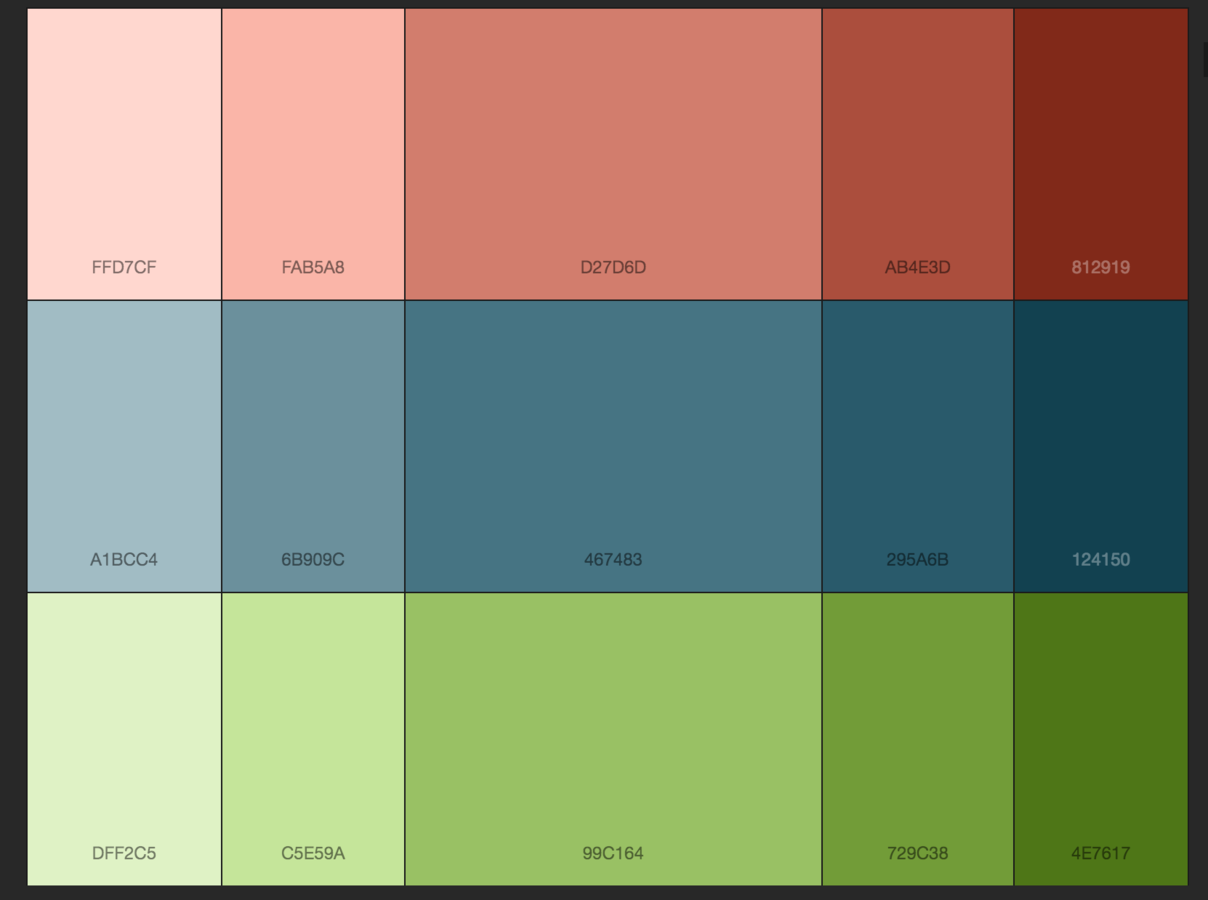
color swatch

AngularConnect with custom colors
@bahmutov
Color pushing by
-
Sitting together with designer
-
Designer running local deploy
-
Something better?
or
or
@bahmutov
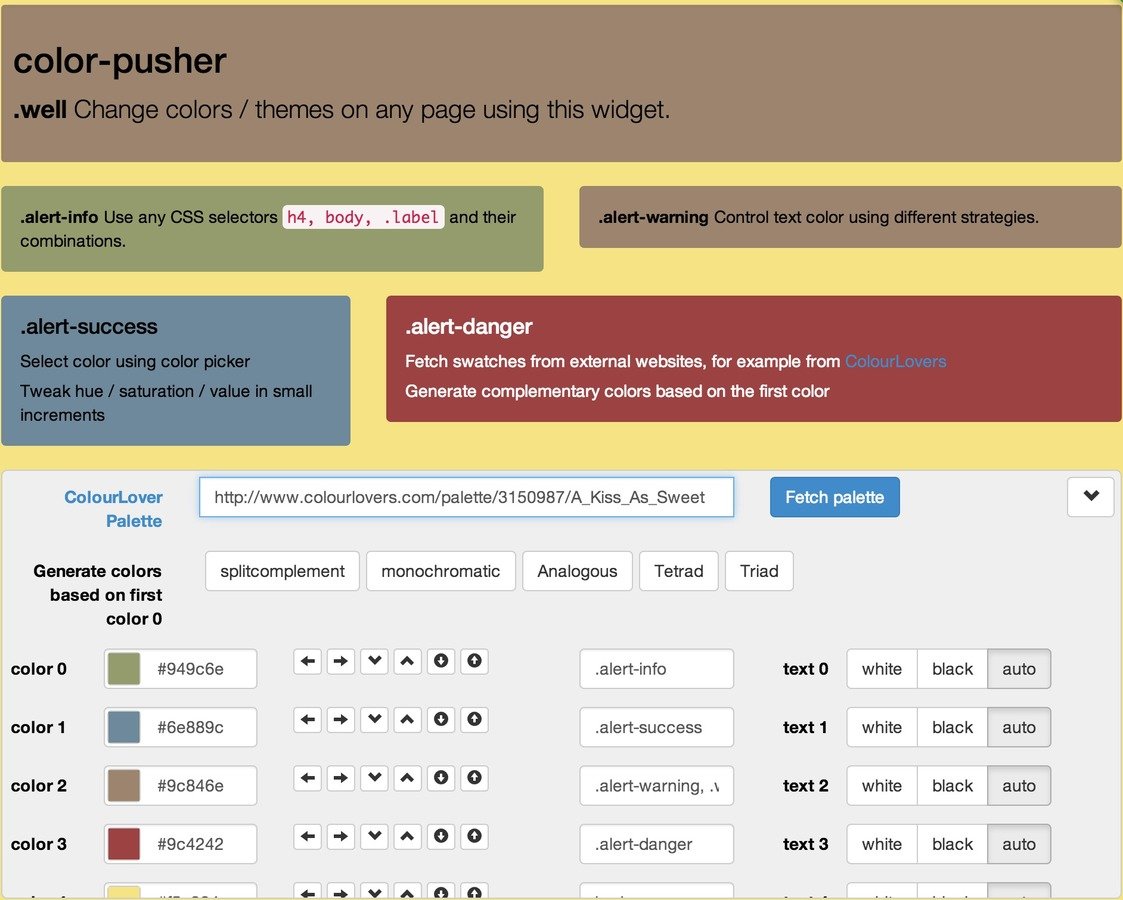
<!-- assumes jQuery / Bootstrap / Angular 1 -->
<link rel="stylesheet" href="color-pusher/dist/color-pusher.css">
<script src="color-pusher/dist/color-pusher.js"></script>// if DEBUG_SERVER
<div ng-app="color-pusher">
<color-pusher></color-pusher>
</div>
// endifIf you own the page
@bahmutov
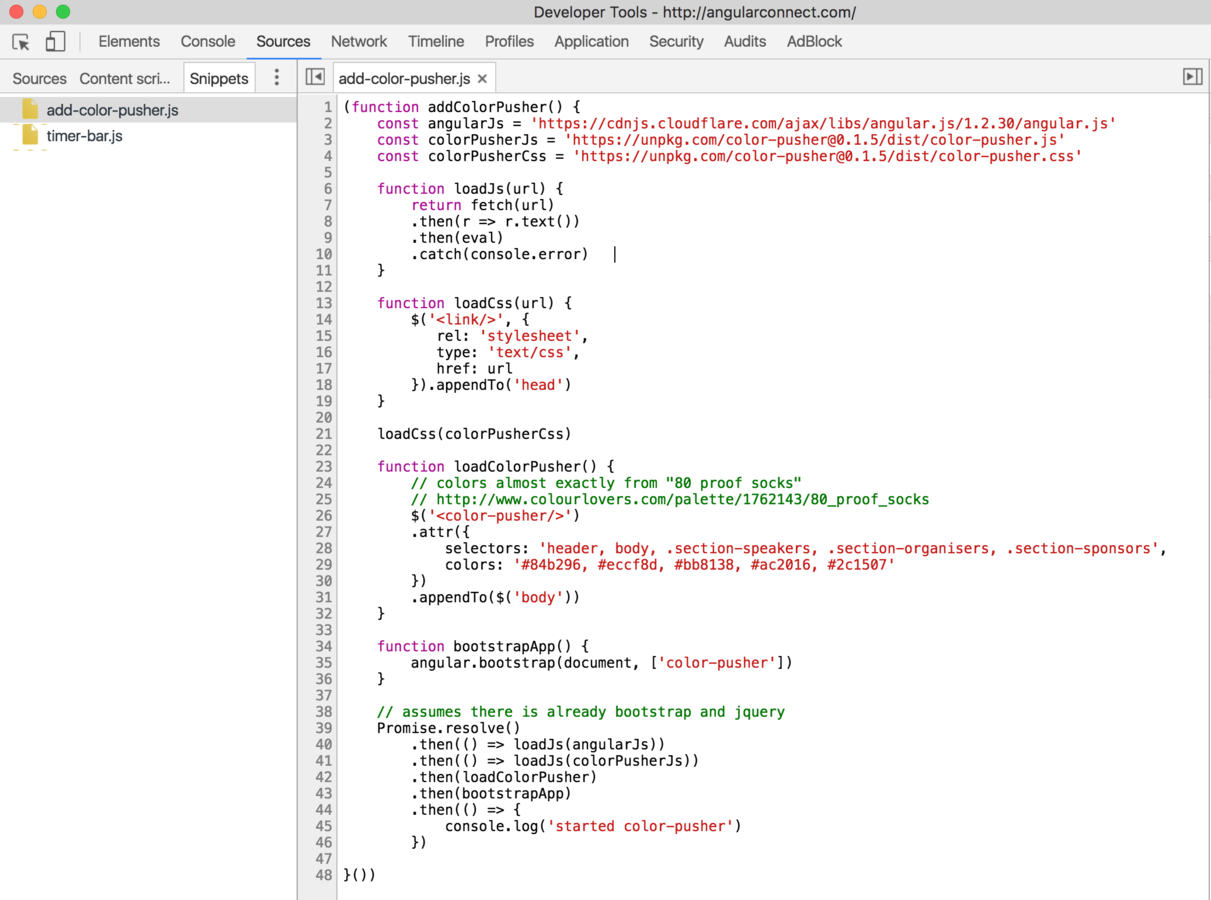
load color-pusher via code snippet
If you do not control the page source

color-pusher demo
color-pusher widget
Requires changes to the page 👎
Creates an extra feature flag / backdoor 👎
@bahmutov
color-pusher code snippet
DevTools, hard to update 👎
@bahmutov
color-pusher Chrome extension!
Can be installed once, auto updates 👍
Can be DevTools panel 👍
@bahmutov
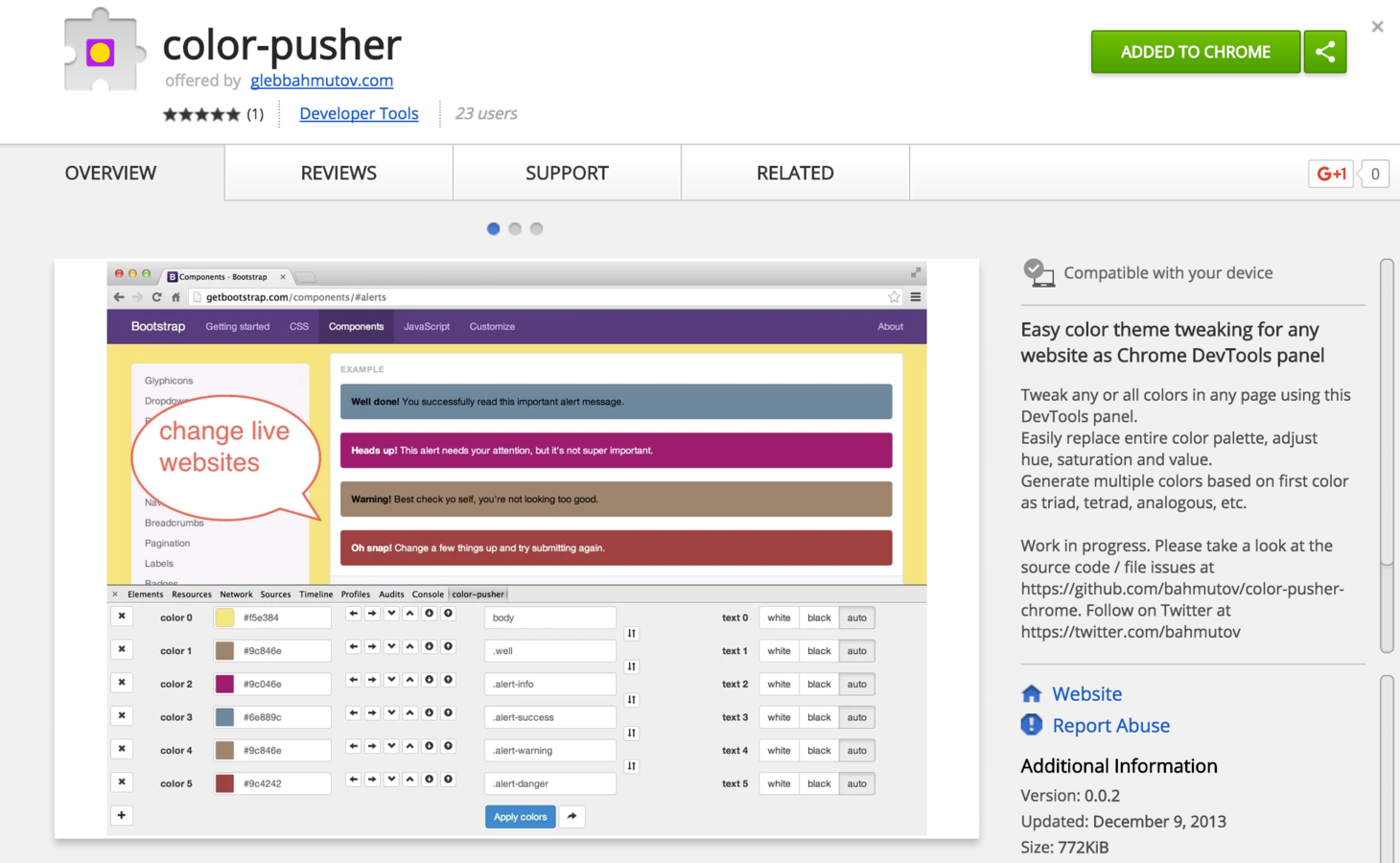
@bahmutov
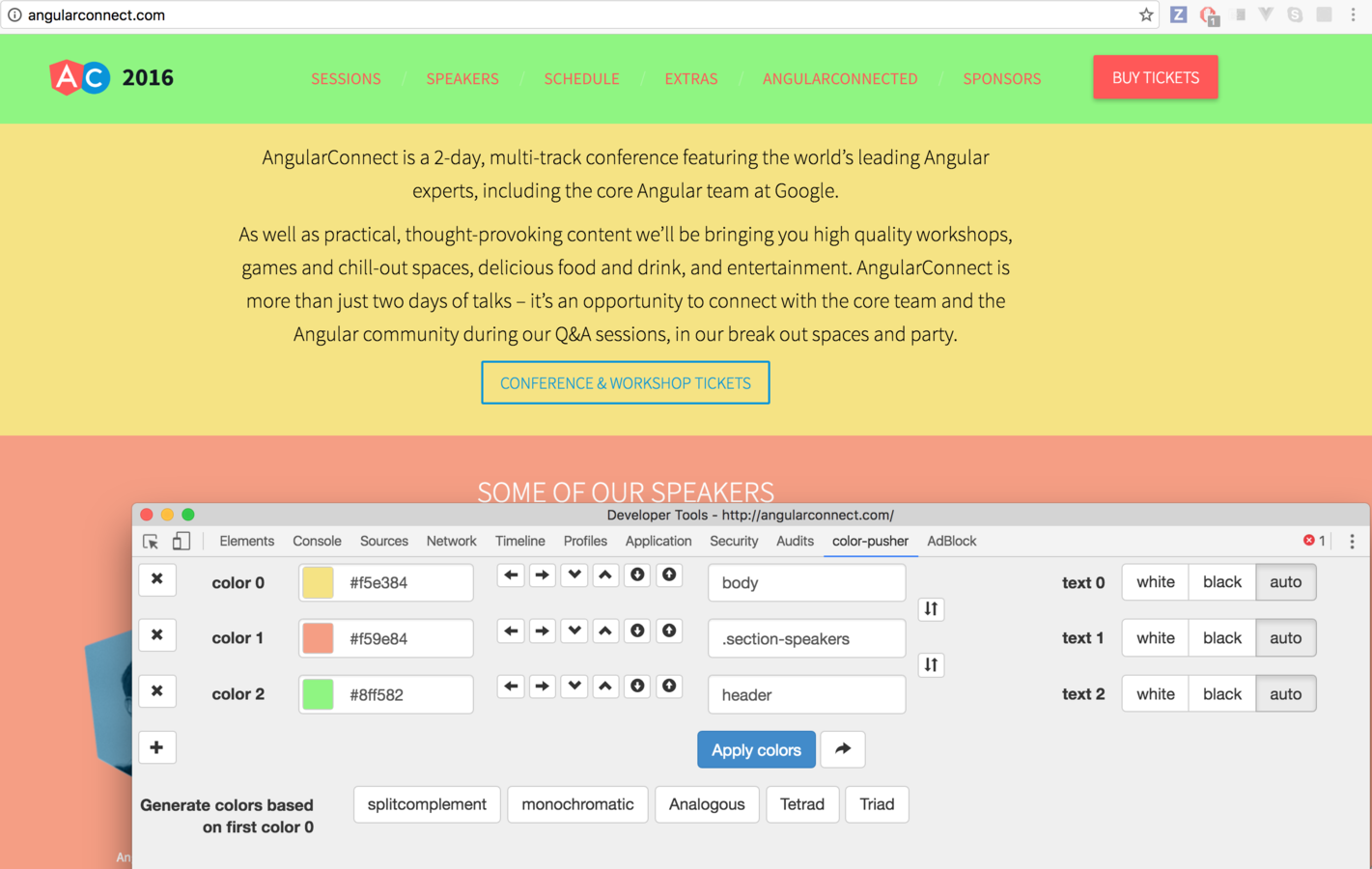
color-pusher DevTools panel
@bahmutov
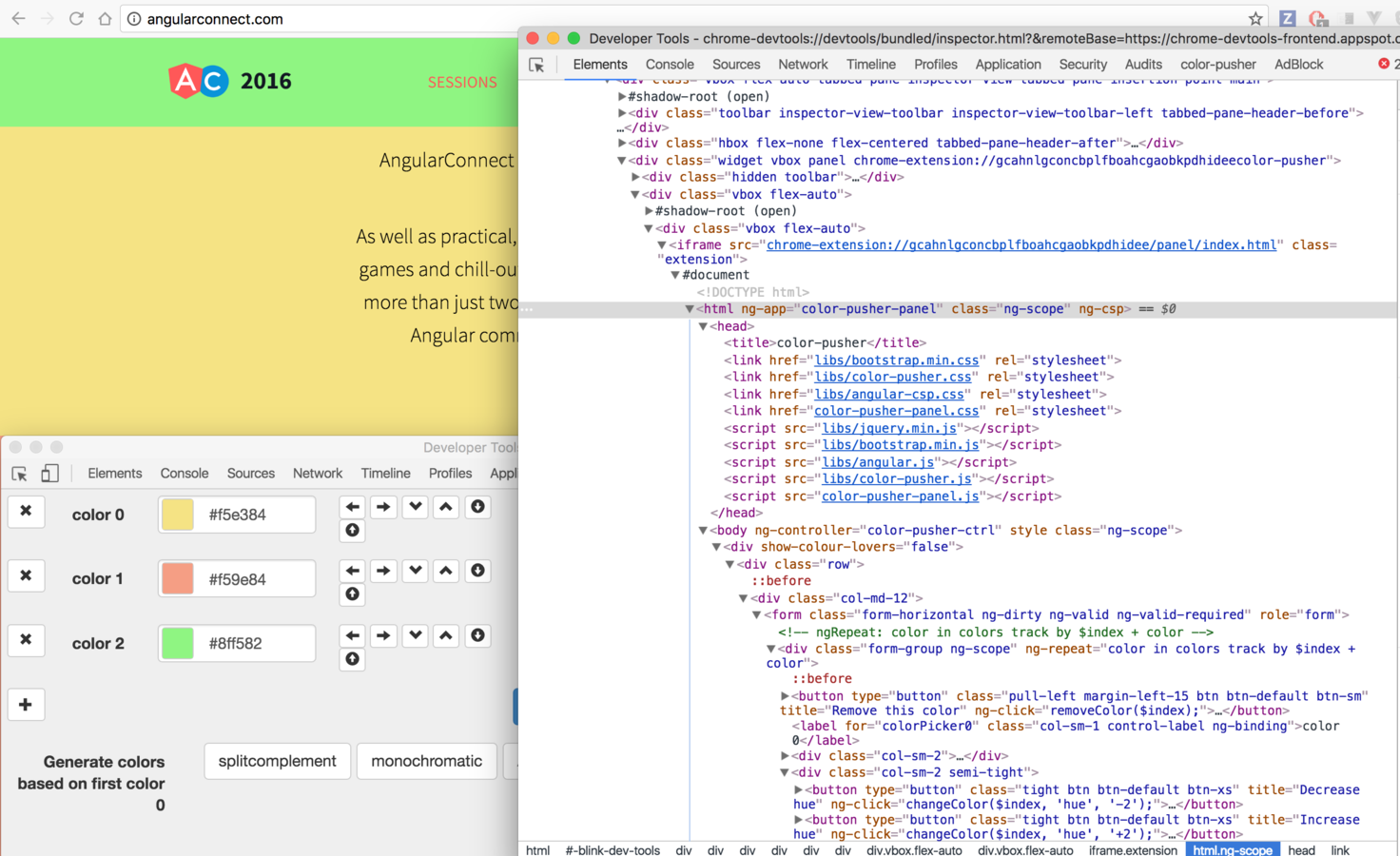
Panels can be inspected just like other web apps in DevTools
@bahmutov
color-pusher extension
<link href="libs/bootstrap.min.css" rel="stylesheet" />
<link href="libs/color-pusher.css" rel="stylesheet" />
<link href="libs/angular-csp.css" rel="stylesheet" />
<link href="color-pusher-panel.css" rel="stylesheet" />
<script src="libs/jquery.min.js"></script>
<script src="libs/bootstrap.min.js"></script>
<script src="libs/angular.js"></script>
<script src="libs/color-pusher.js"></script>
<script src="color-pusher-panel.js"></script>Note 1: where is the lib code?
color-pusher extension
<link href="https://maxcdn.../font-awesome.min.css"
rel="stylesheet" />
<script src="https://code.jquery.com/jquery-3.1.0.min.js">
</script>Can load resources from https, blob, filesystem, http://localhost
@bahmutov
Extension docs
Currently, we allow whitelisting origins with the following schemes: blob, filesystem, https, chrome-extension, and chrome-extension-resource.
@bahmutov
Security rule 1
Whitelisting good behavior works. Blacklisting all possible bad behavior does not.
@bahmutov
Example: make a list of trusted websites
google.com
hackme.com
easymoney.ru
bitcoinz.cn
mybank.ro
netflx.com
...
@bahmutov
Allowing only secure resources (https, wss) is a simple whitelisting rule
@bahmutov
Insecure features are cut

No data from JSONP http
<script src="http://foo...?callback=JSONP">
</script>var url = 'http://www.colourlovers.com/api/palette/'
+ $scope.paletteId
var options = {
url: url,
params: {
format: 'json',
jsonCallback: 'JSON_CALLBACK'
}
}
$http.jsonp(url, options)JSONP({results: 'foo', ...})@bahmutov
Why does JSONP exist?
Why not CORS? Why not https?
@bahmutov
source: http://www.summitpost.org/
JSONP
AJAX
WWW
CORS
HTTPS everywhere

W3C standards
ECMA (JavaScript)
URI and HTTP (IETF)
1989
2000
2004
2006
Remember: Internet is like Rome
On top of Athens
With huge construction going on at all times
Planned in 2 week sprints
@bahmutov
https://www.nostarch.com/tangledweb.htm

Read this book
@bahmutov
color-pusher extension
Note 2: ng-csp
<!DOCTYPE html>
<html ng-csp ng-app="color-pusher-panel">
...
</html>@bahmutov
Quick definitions
Inline script
<script>
alert('foo')
</script><button onclick="alert('foo')">Click</button>@bahmutov
Quick definitions
External script
<script src="lib/foo.js"></script>
<script src="https://whatever.com/foo.js"></script>@bahmutov
Quick definitions
Inline style
<style>
h1 { color: red }
</style><button style="color: red">Click</button>@bahmutov
Quick definitions
External style
<link rel="stylesheet" href="lib/app.css">
<link rel="stylesheet"
href="https://whatever.com/app.css">@bahmutov
Chrome Extension DevTools Panel runs in Content Security Policy (CSP) mode
Angular 1 uses inline styles and eval
By default extension CSP only allows external scripts and styles
@bahmutov
Angular 1 creates inline style tag
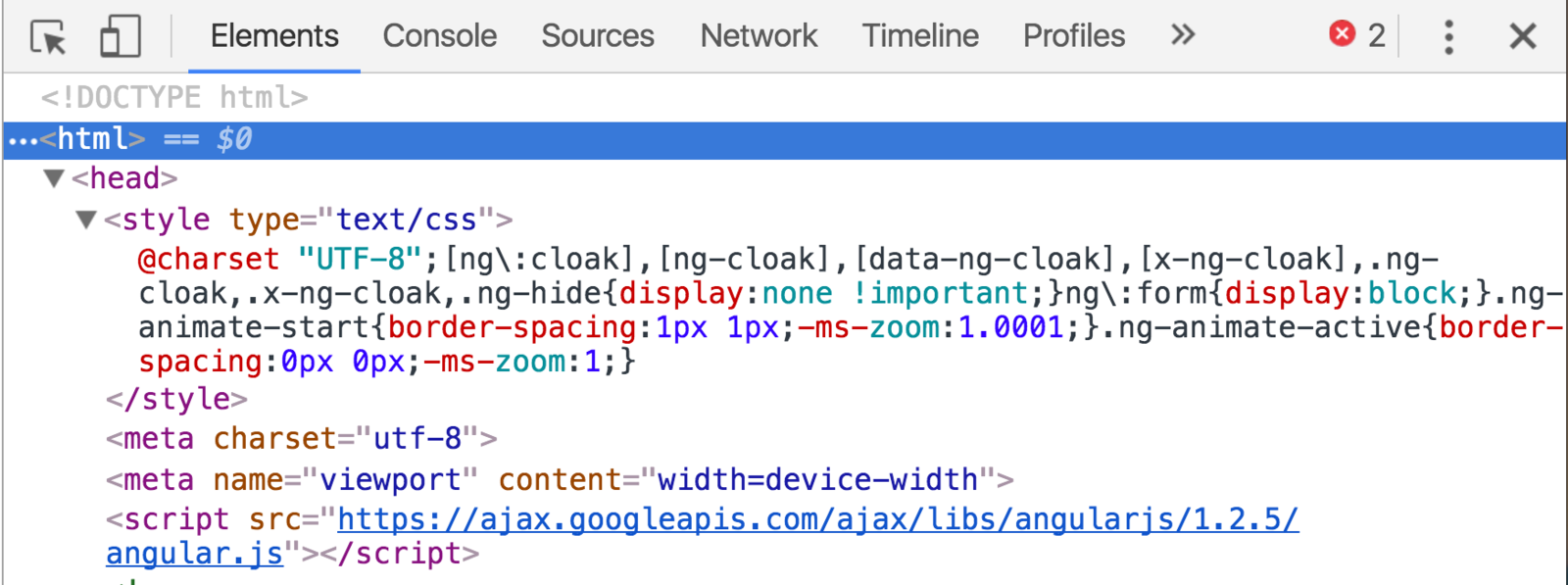
@bahmutov
<!DOCTYPE html>
<html ng-csp ng-app="color-pusher-panel">
<link href="libs/angular-csp.css" rel="stylesheet" />
<script src="libs/angular.js"></script>
</html>Angular 1 in locked down CSP mode
Note: ng-csp mode can make $parse service 30% slower
no eval used
@bahmutov
Present day
Boston, September 2016
@bahmutov

What if a tree's password is stolen in the forest and no one hears it?
@bahmutov

You can have your
website hacked but only once.
@bahmutov
Open Web Application Security Project (OWASP)
Top 10 security threats
@bahmutov
- Injection
- Authentication / session
- Cross-site scripting (XSS)
- Direct object reference
- Security misconfiguration
- Sensitive data exposure
- Lack of access control
- Cross-site request forgery (XSRF)
- Insecure 3rd party code
- Unvalidated redirects
Top 10 attacks 2013

@bahmutov
We will look at these 3 threats
- Injection
- Authentication / session
- Cross-site scripting (XSS)
- Direct object reference
- Security misconfiguration
- Sensitive data exposure
- Lack of access control
- Cross-site request forgery (XSRF)
- Insecure 3rd party code
- Unvalidated redirects
Cross Site Request Funkery: Securing Your Angular Apps From Evil Doers


Dave Smith
Day 1
Track 2
13:50
Panel Q&A: Security and Performance


Martin Probst, Dave Smith, Tim Ruffles and John Mueller
Day 1
Track 5
11:45



Authentication / session
Who are you again?
An attacker impersonating a legitimate user can do a lot of damage
@bahmutov
Common problems
User authentication token is sent via insecure connection
Use https* for every communication link
@bahmutov
https* SSL can be tricky
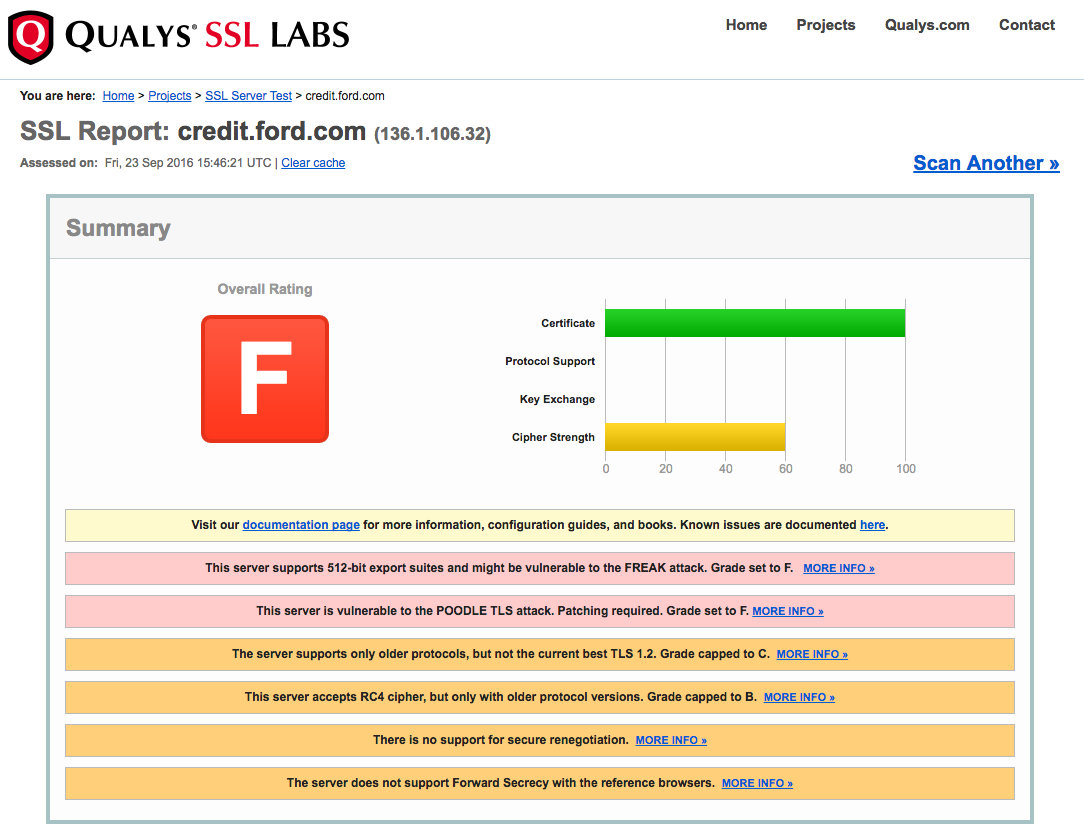
@bahmutov
Old and weak SSL ciphers
nginx config from https://weakdh.org/sysadmin.html
# put strong ciphers first # ban weak ciphers at the end ssl_ciphers 'ECDHE-RSA-AES128-GCM-SHA256:ECDHE-ECDSA-AES128-GCM-SHA256:ECDHE-RSA-AES256-GCM-SHA384:ECDHE-ECDSA-AES256-GCM-SHA384:DHE-RSA-AES128-GCM-SHA256:DHE-DSS-AES128-GCM-SHA256:kEDH+AESGCM:ECDHE-RSA-AES128-SHA256:ECDHE-ECDSA-AES128-SHA256:ECDHE-RSA-AES128-SHA:ECDHE-ECDSA-AES128-SHA:ECDHE-RSA-AES256-SHA384:ECDHE-ECDSA-AES256-SHA384:ECDHE-RSA-AES256-SHA:ECDHE-ECDSA-AES256-SHA:DHE-RSA-AES128-SHA256:DHE-RSA-AES128-SHA:DHE-DSS-AES128-SHA256:DHE-RSA-AES256-SHA256:DHE-DSS-AES256-SHA:DHE-RSA-AES256-SHA:AES128-GCM-SHA256:AES256-GCM-SHA384:AES128-SHA256:AES256-SHA256:AES128-SHA:AES256-SHA:AES:!CAMELLIA:!DES-CBC3-SHA:!aNULL:!eNULL:!EXPORT:!DES:!RC4:!MD5:!PSK:!aECDH:!EDH-DSS-DES-CBC3-SHA:!EDH-RSA-DES-CBC3-SHA:!KRB5-DES-CBC3-SHA';
@bahmutov
SSL part way
http://bahmutov.github.io
https://glebbahmutov.com
GitHub pages
CloudFlare

@bahmutov
Insecure auth token storage
Auth cookie not marked "httpOnly" and "secure"
cookie cannot be accessed by JavaScript code
cookie only included with https requests
+ "SameSite"
@bahmutov
General advice
Leave password management and authentication to the professionals
@bahmutov
Cross-site scripting (XSS)
Is this code or data?
Attacker's input is treated as trusted code and is executed when another user views the website
@bahmutov
Name:
John Doe
<span>{{ name }}<span>
<span>John Doe<span>
@bahmutov
Name:
<script>alert('hi')</script>
<span>{{ name }}<span>
<span><script>alert('hi')</script><span>
innerText or innerHTML?
@bahmutov
innerText or innerHTML?
Direct text or escaped? ">" or ">"
@bahmutov
innerText or innerHTML?
Dangerous, but has styling, elements, etc
Really dangerous if one user's content
can be viewed by another user
@bahmutov
My Site
My content
User comments
Ads, etc
<script>stealStuff()</script>
@bahmutov
Will a script embedded in the user-entered content be executed (for another user)?
NEVER EVER EVER?
@bahmutov
Not to us!
source: www.brit.co/latte-art/
@bahmutov
Story time: how bad things happen to good people
@bahmutov
// server
const app = koa()
app.use(function * () {
this.render('index.jade', {
greeting: 'Hello world'
})
})// Jade template
doctype html
html(lang="en")
head
title Example
body
h1 #{greeting}@bahmutov
<body>
<h1>Hello world</h1>
</body>@bahmutov
// server
const app = koa()
app.use(function * () {
this.render('index.jade', {
greeting: '<script>alert("1");</script>'
})
})// Jade template
doctype html
html(lang="en")
head
title Example
body
h1 #{greeting}Jade variables are HTML escaped by default
@bahmutov
<body> <h1><script>alert("1");</script></h1> </body>
@bahmutov
// server
const app = koa()
app.use(function * () {
this.render('index.jade', {
greeting: '{{ a + b }}'
})
})// Jade template
doctype html
html(lang="en")
head
title Example
body
h1 #{greeting}@bahmutov
<body>
<h1>{{ a + b }}</h1>
</body>
@bahmutov
// server
const app = koa()
app.use(function * () {
this.render('index.jade', {
greeting: '{{ a + b }}'
})
})// Jade template
doctype html
html(lang="en")
head
script(src="https://code.angularjs.org/1.0.1/angular-1.0.1.js")
title Example
body(ng-app)
h1 #{greeting}Angular template
@bahmutov
<body ng-app="" class="ng-scope"> <h1 class="ng-binding">0</h1> </body>
@bahmutov
"AngularJS better not execute {{ <script>...</script> }} tags or I will loose it!"
@bahmutov
AngularJS does NOT execute {{ <script>...</script> }} tags
@bahmutov
// server
const app = koa()
app.use(function * () {
this.render('index.jade', {
greeting: 'Hi {{constructor.constructor(\'alert(1)\')()}}'
})
})// Jade template
doctype html
html(lang="en")
head
script(src="https://code.angularjs.org/1.0.1/angular-1.0.1.js")
title Example
body(ng-app)
h1 #{greeting}@bahmutov
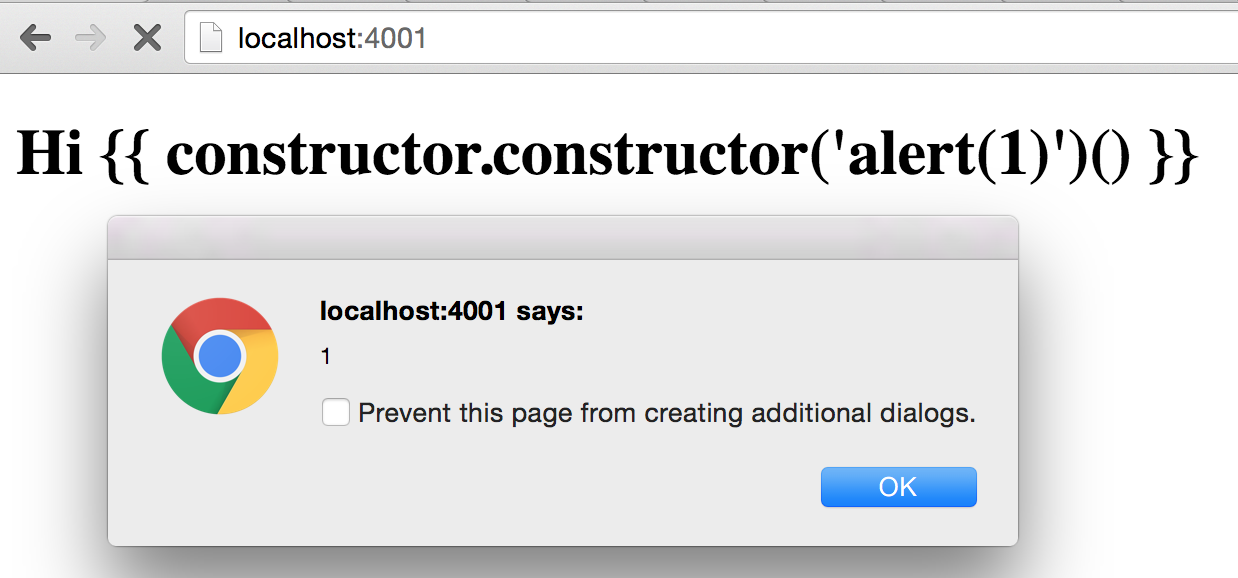
@bahmutov
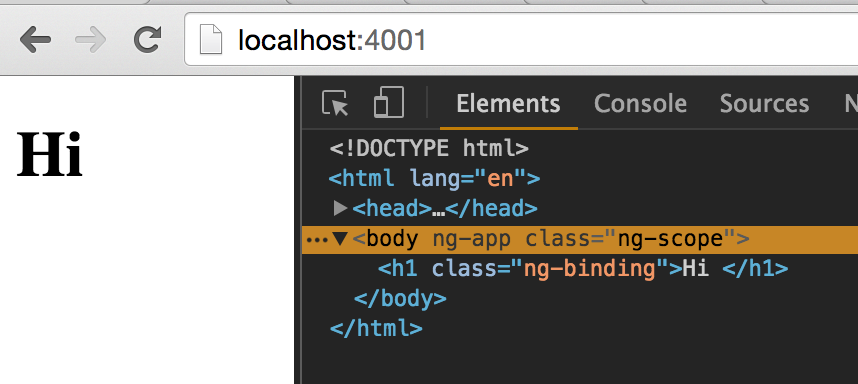
Template is NOT in DOM
@bahmutov

Runs on every digest cycle
Mismatch between Jade, Angular, template strings and developer's expectations
@bahmutov
constructor.constructor
{{ eval('alert(42)') }}
// does not work{{ Function('alert(42)')() }}
// does not work
// this $scope.Function...@bahmutov
constructor.constructor
var f = {}
f.constructor
// function Object(){[native code]}f.constructor.constructor
// function Function(){[native code]}Need to get "Function" somehow
{{constructor.constructor('alert(1)')()}}
@bahmutov
Will never happen to me
Angular 1.0 edition
{{constructor.constructor('alert(1)')()}}
fixed in Angular 1.2
@bahmutov

constructor.constructor
@bahmutov
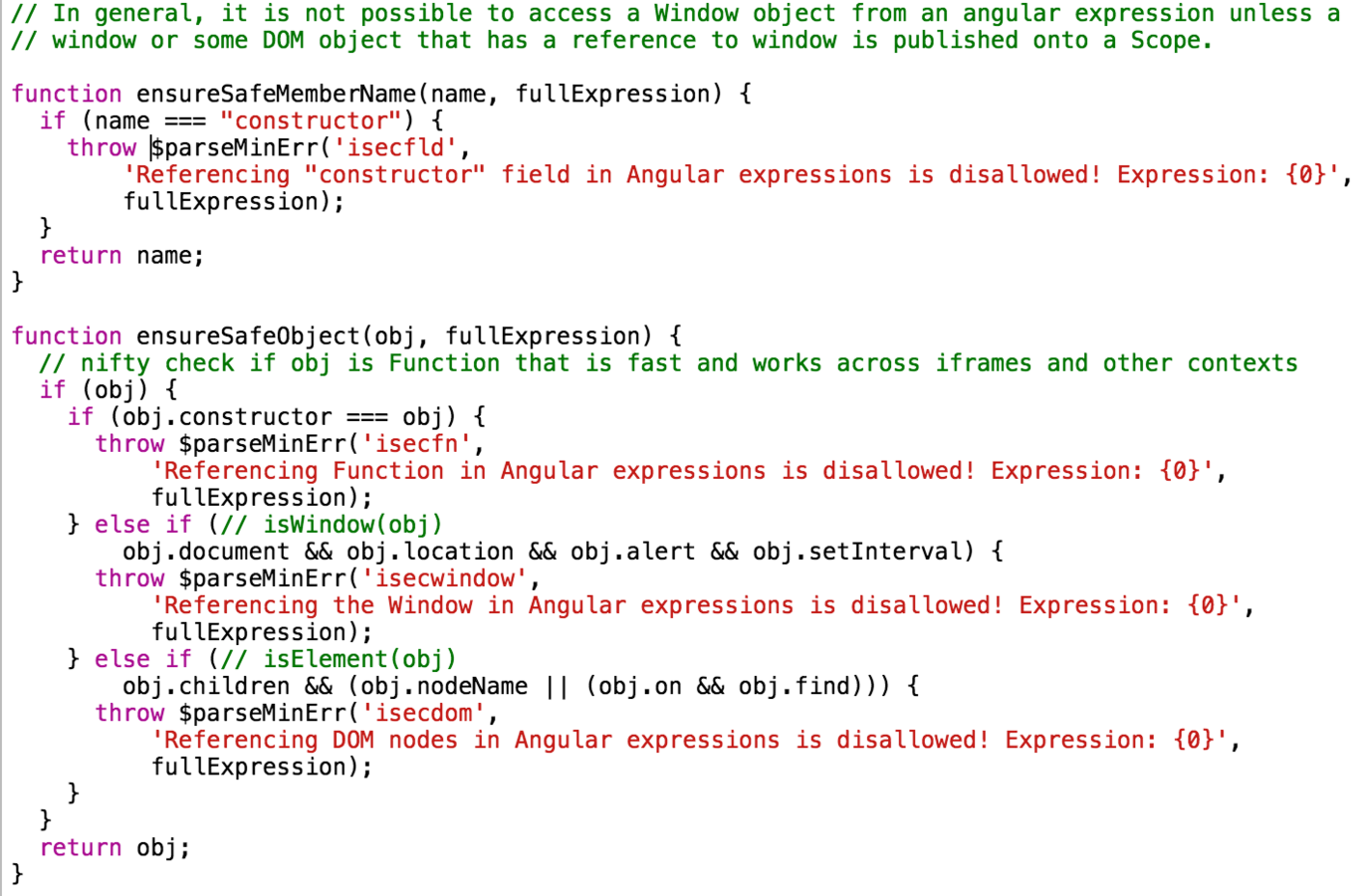
Blacklisting
@bahmutov
// Sandboxing Angular Expressions
// ------------------------------
// Angular expressions are generally considered safe because these expressions only have direct
// access to $scope and locals. However, one can obtain the ability to execute arbitrary JS code by
// obtaining a reference to native JS functions such as the Function constructor.
//
// As an example, consider the following Angular expression:
//
// {}.toString.constructor(alert("evil JS code"))
//
// We want to prevent this type of access. For the sake of performance, during the lexing phase we
// disallow any "dotted" access to any member named "constructor".
//
// For reflective calls (a[b]) we check that the value of the lookup is not the Function constructor
// while evaluating the expression, which is a stronger but more expensive test. Since reflective
// calls are expensive anyway, this is not such a big deal compared to static dereferencing.
//
// This sandboxing technique is not perfect and doesn't aim to be. The goal is to prevent exploits
// against the expression language, but not to prevent exploits that were enabled by exposing
// sensitive JavaScript or browser apis on Scope. Exposing such objects on a Scope is never a good
// practice and therefore we are not even trying to protect against interaction with an object
// explicitly exposed in this way.
//
// A developer could foil the name check by aliasing the Function constructor under a different
// name on the scope.
//
// In general, it is not possible to access a Window object from an angular expression unless a
// window or some DOM object that has a reference to window is published onto a Scope.
Angular expressions are generally considered safe
Blacklisting and setting high security expectations are difficult to pull off
@bahmutov
{{ (_=''.sub).call.call({}[$='constructor'].getOwnPropertyDescriptor ( _.__proto__,$).value,0,'alert(1)')() }}
Will never happen to me
continued
works in Angular 1.2
@bahmutov
{{ objectPrototype = ({})[['__proto__']]; objectPrototype[['__defineSetter__']]('$parent', $root.$$postDigest); $root.$$listenerCount[['constructor']] = 0; $root.$$listeners = [].map; $root.$$listeners.indexOf = [].map.bind; functionPrototype = [].map[['__proto__']]; functionToString = functionPrototype.toString; functionPrototype.push = ({}).valueOf; functionPrototype.indexOf = [].map.bind; foo = $root.$on('constructor', null); functionPrototype.toString = $root.$new; foo(); }} {{ functionPrototype.toString = functionToString; functionPrototype.indexOf = null; functionPrototype.push = null; $root.$$listeners = {}; baz ? 0 : $root.$$postDigestQueue[0]('alert(location)')(); baz = true;'' }}
Will never happen to me
for Angular 1.3
@bahmutov
{{ 'this is how you write a number properly. also, numbers are basically arrays.'; 0[['__proto__']].toString = [][['__proto__']].pop; 0[['__proto__']][0] = 'alert("TROLOLOLn"+document.location)'; 0[['__proto__']].length = 1; 'did you know that angularjs eval parses, then re-stringifies numbers? :)'; $root.$eval("x=0", $root); }}
Will never happen to me
for Angular 1.4
@bahmutov
Searching for sandbox escapes
@bahmutov
Sandbox escapes matter today
Udemy, Microsoft Support 1.4.9
Indiegogo 1.4.8
Google Insights 1.3.15
JetBlue, Ford 1.2.8
Viacom 1.0.8
@bahmutov
Vue.js
The double mustaches interprets the data as plain text, not HTML. In order to output real HTML, you will need to use triple mustaches
constructor.constructor escape works
{{
vue.$el.insertAdjacentHTML('afterend',
'<script>alert(1)</script>')
}}Aurelia
constructor.constructor escape works

@bahmutov
Angular 1.6
The Angular expression sandbox will be removed from Angular from 1.6 onwards, making the code faster, smaller and easier to maintain
Expression Sandbox Removal
@bahmutov
Angular 1.6
the existence of the sandbox only made some developers incorrectly believe that the expression sandbox protected them [from XSS attacks]
Expression Sandbox Removal
@bahmutov
Angular 2
Angular templates are the same as executable code
constructor.constructor escape works
@bahmutov
Lesson: you cannot sanitize your way out of <script> tags.
At least warn people!
@bahmutov
Solution: disable inline JavaScript
<body>
<script>function willNotRun() {...}</script>
<script src="assets/js/script.js"></script>
</body>external
inline
@bahmutov
Attacker (probably*) cannot change JavaScript on our server
@bahmutov
Disable inline JavaScript with Content-Security-Policy header
Content-Security-Policy:
default-src 'self';
script-src 'self' ajax.googleapis.com/angularjs/1.5.8/
Wide support for CSP (browsers, web apps)
@bahmutov
GitHub headers
$ curl -I https://github.com/
HTTP/1.1 200 OK
Server: GitHub.com
Date: Thu, 21 Jan 2016 00:23:13 GMT
Content-Type: text/html; charset=utf-8
Status: 200 OK
Cache-Control: no-cache
Vary: X-PJAX
X-UA-Compatible: IE=Edge,chrome=1
Set-Cookie: logged_in=no; domain=.github.com; path=/; expires=Mon, 21 Jan 2036 00:23:13 -0000; secure; HttpOnly
X-Request-Id: 49ac67736ceec9bf127572e7c42c8235
X-Runtime: 0.007182
Content-Security-Policy: default-src *; base-uri 'self';
connect-src 'self' live.github.com wss://live.github.com uploads.github.com status.github.com
api.github.com www.google-analytics.com api.braintreegateway.com client-analytics.braintreegateway.com
github-cloud.s3.amazonaws.com; font-src assets-cdn.github.com; form-action 'self' github.com
gist.github.com; frame-src 'self' render.githubusercontent.com gist.github.com checkout.paypal.com;
img-src 'self' data: assets-cdn.github.com identicons.github.com www.google-analytics.com
checkout.paypal.com collector.githubapp.com *.githubusercontent.com *.gravatar.com *.wp.com;
media-src 'none'; object-src assets-cdn.github.com; script-src assets-cdn.github.com;
style-src 'self' 'unsafe-inline' 'unsafe-eval' assets-cdn.github.com
Strict-Transport-Security: max-age=31536000; includeSubdomains; preload
Public-Key-Pins: max-age=300; pin-sha256="WoiWRyIOVNa9ihaBciRSC7XHjliYS9VwUGOIud4PB18="; pin-sha256="JbQbUG5JMJUoI6brnx0x3vZF6jilxsapbXGVfjhN8Fg="; includeSubDomains
X-Content-Type-Options: nosniff
X-Frame-Options: deny
X-XSS-Protection: 1; mode=block
Vary: Accept-Encoding
X-Served-By: d0e230454cb69aa01d4f86fc3a57b17f
X-GitHub-Request-Id: AC552DBA:3AD3:FB489A:56A024F1Disable inline JavaScript using meta tag
<meta http-equiv="Content-Security-Policy"
content="script-src 'self'; ....">
Wide support for CSP (browsers, web apps)
@bahmutov
// server
const app = koa()
app.use(function * () {
this.render('index.jade', {
greeting: 'Hi {{constructor.constructor(\'alert(1)\')()}}'
})
})// Jade template
doctype html
html(lang="en")
head
meta(http-equiv="Content-Security-Policy",
content="script-src https://code.angularjs.org 'self';")
script(src="https://code.angularjs.org/1.0.1/angular-1.0.1.js")
title Example
body(ng-app)
h1 #{greeting}Back to our example
Added
@bahmutov

@bahmutov
// server
const app = koa()
app.use(function * () {
this.render('index.jade', {
greeting: 'Hi {{40 + 2}}'
})
})Regular Angular expressions work with CSP
@bahmutov
// server
const app = koa()
const helmet = require('koa-helmet')
app.use(helmet.csp({
directives: {
defaultSrc: [],
scriptSrc: ['https://code.angularjs.org'],
styleSrc: [],
imgSrc: [],
objectSrc: [],
sandbox: ['allow-scripts']
}
}))
// $ http localhost:4001
// HTTP/1.1 200 OK
// Content-Security-Policy: default-src; \
// script-src https://code.angularjs.org; \
// style-src; img-src; object-src; sandbox allow-scriptsUse response headers for CSP

app.get('/', function (req, reqs) {
res.render('index', {
title: 'Example',
analyticsId: '4xy-0123456'
});
});head
title #{ title }
script.
var analyticsId = '#{ analyticsId }';
script.
// use variable analyticsIdinline
Problems: Server-side templates:
Solution: render external JS
// analytics-config.js
var analyticsId = '4xy-0123456';
head
meta(http-equiv="Content-Security-Policy",
content="script-src 'self';")
title #{ title }
script(src="js/analytics-config.js")
script(src="js/analytics.js")@bahmutov
js-to-js middleware
// views/config.js
module.exports = {
analyticsId: 'default-id'
}
// server.js
var app = require('express')()
var jsToJs = require('js-to-js')
app.engine('js', jsToJs)app.get('/js/analytics-config.js', function (req, res) {
res.setHeader('content-type', 'application/javascript');
res.render('config.js', {
analyticsId: '4xx-xxxxx'
});
});actual value
@bahmutov
js-to-js middleware
// js/config.js
var analyticsConfig = {
"analyticsId": "4xx-xxxxx"
};User receives
@bahmutov
js-to-js also wraps JS scripts (like Google Analytics)
@bahmutov
Pass entire config at once
var jsToJs = require('js-to-js');
app.get('/js/config.js',
jsToJs('demoConfig', { foo: 42, bar: 21 }));User receives
// js/config.js
var demoConfig = { foo: 42, bar: 21};@bahmutov
With a little help, Express/Hapi/... can send ZERO inline JavaScript
@bahmutov

It is free!
CSP + Ng downsides
CSP Is Dead, Long Live CSP!
On the Insecurity of
Whitelists and the Future of Content Security Policy
@bahmutov
There are weird Angular template exploits that do not need "Function" or "eval" (bypassing CSP)
@bahmutov
The solution is a very strict user data validation against whitelist of rules
@bahmutov
CSP in WebWorkers
new Worker(URL.createObjectURL(blob))uses CSP of the parent document
new Worker('worker.js')uses CSP in Content-Security-Policy HTTP header
@bahmutov
CSP in WebWorkers
Bad news: this is CSP level 2 spec
NOT supported by IE / Edge
Whitelist allowed worker locations using 'child-src' CSP property
@bahmutov
XSS in ServiceWorker
If an attacker can load a malicious ServiceWorker
It will be HARD to remove it
@bahmutov
XSS into ServiceWorker via JSONP :)
Discussed in this Chromium thread
https://bugs.chromium.org/p/chromium/issues/detail?id=422966
@bahmutov
Insecure 3rd party code
Just add one more library
Are you using a library with a known security vulnerability?
@bahmutov
Upgrade to safe version
@bahmutov
Using old versions is a technical debt and a security risk
@bahmutov
Insecure 3rd party code
We trust this library
Can an attacker change our server / web app code?
@bahmutov
If using CDN
Be sure CDN serves what you expect using Server Resource Integrity (SRI)
<script src="https://example.com/example-framework.js"
integrity="sha384-oqVuA..."
crossorigin="anonymous"></script>Chrome & Firefox only http://caniuse.com/#feat=subresource-integrity
@bahmutov
If using NPM
A simple Node server example depends on > 100 modules
@bahmutov
NPM for server
webpack / browserify
loaders
gulp / grunt
build plugins
lint tools
Bower for web
jQuery
Angular
Bootstrap
App code
@bahmutov
NPM for server and web
webpack / browserify
jQuery
loaders
App code
Angular
gulp / grunt
Bootstrap
build plugins
lint tools
NPM checksums (like SRI) https://github.com/zaach/npm-seal
jade-angular-template-attack@1.0.0
├─┬ koa@1.2.0
│ ├─┬ accepts@1.3.2
│ │ └── negotiator@0.6.0
│ ├── co@4.6.0
│ ├─┬ composition@2.3.0
│ │ └── any-promise@1.1.0
│ ├── content-disposition@0.5.1
│ ├── content-type@1.0.1
│ ├─┬ cookies@0.6.1
...npm list
@bahmutov
What if someone unpublished negotiator@0.6.0 and then published malicious code under negotiator@0.6.0?
negotiator@0.6.1?
@bahmutov
Kik-gate
@bahmutov
- Guy has bunch of NPM modules including "kik" and "left-pad"
- Company Kik asks him to release "kik" name from NPM registry
- Guy refuses
- Kik goes to NPM Registry Co and Co gives "kik" name to Kik
- Guy gets angry and removes ALL his packages from NPM registry
- Bunch of packages depend on "left-pad" and stop working
- Guy #2 grabs the released names AND PUBLISHES his code under same names and versions
- NPM Registry Co un-unpublishes original modules
- NPM Registry co changes its "unpublishing policy"
@bahmutov
You cannot* unpublish after 24 hours
Even unpublishing after 1 second is a RISK
* "fs" unpublished and restored: http://status.npmjs.org/incidents/dw8cr1lwxkcr
New NPM policy
@bahmutov
If you push sensitive info to public GitHub or publish to NPM registry - it is out
Problem: Can someone publish under YOUR name?
@bahmutov
All major NPM projects has some sensitive information leaked
NPM auth token, GitHub tokens, passwords, SSH keys, etc
@bahmutov
Solution = prevention
-
Code and security reviews, checklists
-
ban-sensitive-files NPM module
@bahmutov
Lessons and conclusions
@bahmutov
Match expectations
Each public project: library, framework and application should a security page
@bahmutov
If you find a security flaw
node / npm package
@bahmutov
Review the boundary code periodically
(your) simple code is secure
Code is rarely simple
@bahmutov
function f() {
alert('foo')
}
@bahmutov
f``
@bahmutov
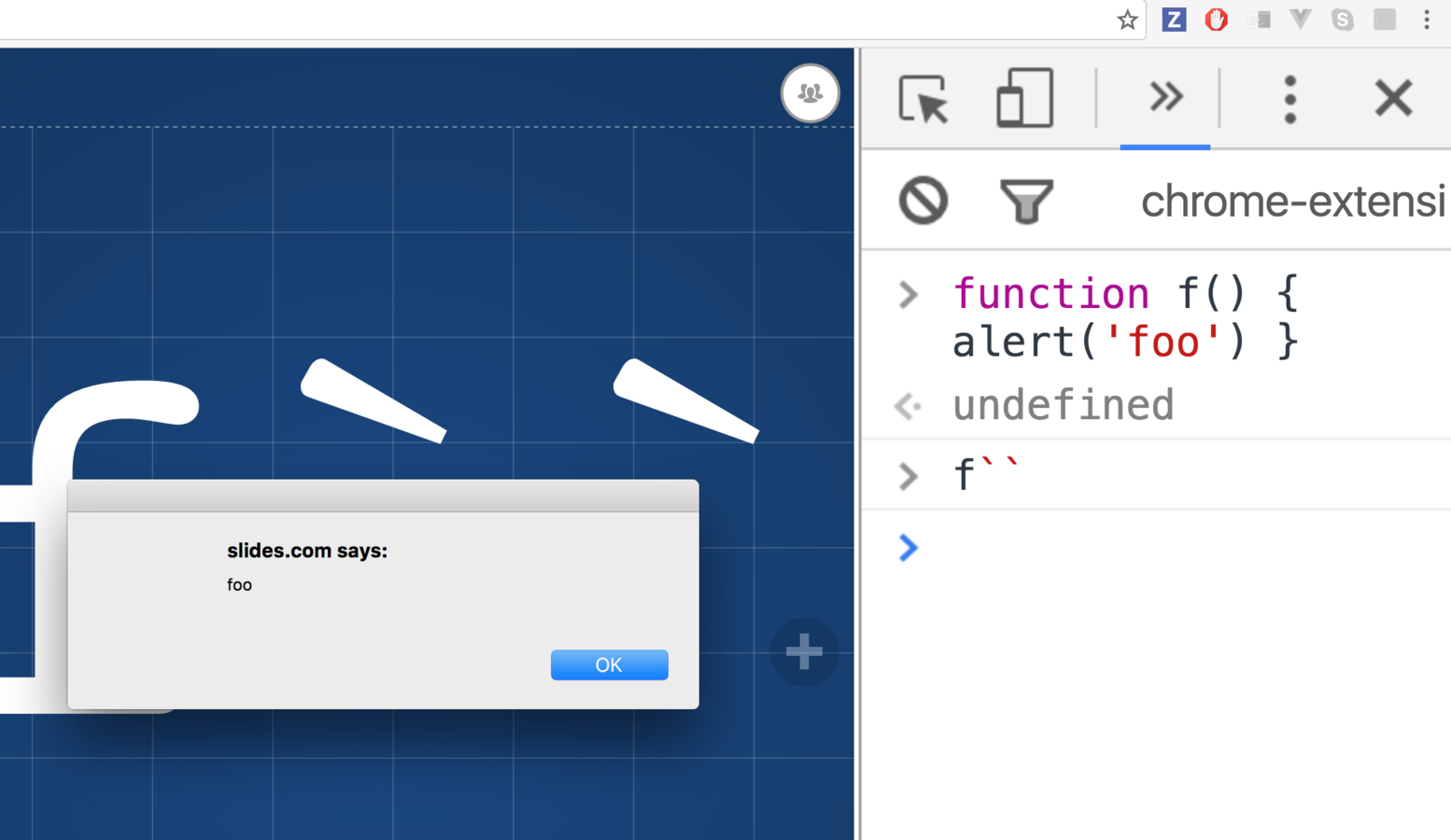
WHAT?!
@bahmutov

ES6 - WAT?!

Shai Reznik says
@bahmutov
f`` - popup
f - popup
``
f; - no popup
``
@bahmutov
ES6 Symbols - customize JS
- @@iterator to make the object iterable
- @@hasInstance to customize instanceof
- @@toPrimitive to convert an object to a primitive
- @@toStringTag to create the default description of an object
- @@species to create derived objects
- Create regular expression like objects: @@match, @@replace, @@search and @@split
- @@isConcatSpreadable to flat an object to array elements
- @@unscopables for properties accessibility within with
@bahmutov
Test262 is a JavaScript Sideshow
Mike Pennisi
When we started extending Test262 to cover brand new language features, we knew we were in for some surprises. Even so, we never could have anticipated the horrors we would uncover.
Test262 is a JavaScript Sideshow
Mike Pennisi
... However, these language features can sometimes interact in strange ways. ... All of it is valid JavaScript, ... None of it would be accepted in a code review.
Implement the security early
It is much harder to secure a system later
Crash reporting can warn you about CSP violations and JS probing
@bahmutov
Hacking is a question of economics
Make yourself too expensive to hack for the value you protect!
@bahmutov
Thank you


Stay safe!
@bahmutov
Day 1
Track 2
11:00
slides.com/bahmutov/angular-connect-2016